Brtníky. Formerly Zeidler. Both names are honey. In the Middle Ages, extensive apiaries were established here and their keepers were called ZEIDLER, i.e. fathers of bees. When the Second World War ended many hundreds of years later and the original population was driven off the land, a Czech name was searched for and searched for, fortunately, in the same drawer. And so brats, so you, who took care of the bee colonies in the hives, i.e. tree hollows, they gave the village its name a second time. It’s nice to know though, that the name could also sound like Father of the Bees. So let’s be a bee for a moment, let’s fly out of the hive and explore the village, whose fame suffered a lot and was forgotten by many, and she is full of remarkable traces of past lives and seeds of hope.
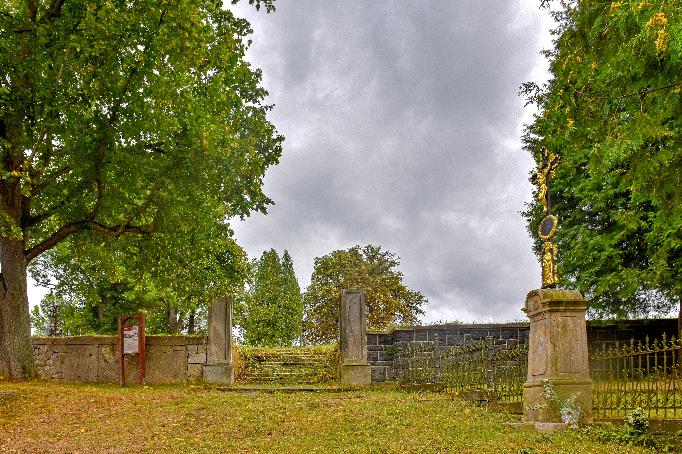
Because we are bees, it draws us to the crowns of flowering linden trees in the very center of Brtníky. A strange abandoned place – that is, today. Retaining Wall, stairs, two pedestals… something had to stand here. Something big and quite possibly even beautiful…

But there is only an empty space above the stairs with a huge cross. It is a reminder of the building, which here
it was still in the year 1974.

A beautiful baroque church with a polygonal tower and an unusual end of the chancel. Church consecrated
St. Martin was built in less than seven years by the most important Baroque builder of the entire region,
Zacharias Hoffmann from Lipová. Year, same, who built the Salm castle in Lipová, but also
Lobendavian, Śluknov and Mikulášovice churches, the triple side and Balzer’s chapel in Mikulášovice… Simply
local star. It was completed in a year 1716. No, actually no…

It was actually completed 19. February 1975. Then the church was blown up and since then the panorama
villages do not decorate. A bit of a crazy end to a stunning build, and so, after years, the secrets of its interiors were revealed? The post-war development was not very favorable for this jewel of folk architecture, after the February coup, the temples of the Lord
they weren’t very popular. They were rather a thorn in the side of the Bolsheviks.

And it used to be a really beautiful church. The opulent Baroque interior was crowned by an altarpiece of St. Martin, whose author was another regional celebrity – the excellent painter Dominik Kindermann, whose altarpieces can still be admired today, for example, in St. Mary Magdalene in Krásná Lípa or in Starokrečany, Jiříkov or Českokamenicky church.

Even before we fly past other sacred buildings, building blocks and cannons, let’s move to
the industrial past of the village, which today has some two hundred and fifty souls, whereas in the times of the greatest chirping it used to have around seventeen hundred inhabitants. They are fine in the photo of the center of the village
visible factories of the Klinger brothers, local entrepreneurs, who first jointly and after the split of the company
separately, they were among the most important textile entrepreneurs in the region, which was textile through and through.
Factory in the background, therefore, understood building, has survived to this day.

It is empty, and literally. No floors, no ceilings. The breathtaking space is floor to ceiling
free. She should have gone to earth some time ago, but a group of enthusiasts and lovers of Brtník and their history and traditions
she saved the building. I want this, by itself, a lot of money, but once, maybe, there will be a gallery. And you are
write, that it would be one of the most remarkable galleries in the country—whatever it exhibited.
That space is truly unique. By the way, the small building on the right was also saved. And it’s in that one
today… anyway, come on, let’s fly in and see for ourselves – we are bees after all, and so we fly through i
through a small crack in the window…

And vida – the studio… Miloš Kubišta’s Kingdom, an artist, sculptor and restorer, one of the Brtnica enthusiasts mentioned a moment ago. With his wife Jitka, he runs a charming cafe – wine bar in Krásná Lípa, which is called… you can’t guess it: Atelier.

It’s incredibly lovely, that in places, where women used to dress, a naked woman rests now.

And this is what both buildings looked like in those days, when they employed dozens, even hundreds of people from the surrounding area. One
among them was a certain Josef Müller from Alt-Ehrenberg, i.e. the Old Greeks, under which Brtníky today
they fit correctly. This Pepi Müller was extraordinarily clever. He graduated from vocational school
knitting school in Krásná Lípa and in 1905 joined the beer company Klinger, where to
he gradually worked his way up to the head of operations. But that’s not the most interesting thing…
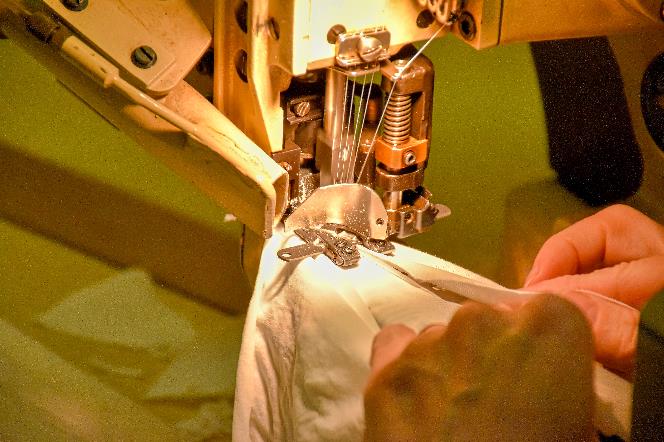
In the early 1930s, with the help of his daughter Gertrude, he developed pantyhose for
children. The whole trick was to insert wedges between two knitted stockings – after all, that’s how it’s done
until today. As shown by careful tracing, is Josef Müller really the inventor of this type
clothes. Alone to him sometime in the year 1935 coined the term “strumpfhosen”, Czech: tights.
Merchants did not believe the news very much at first, but the tights were enthusiastically received by the people. In the half
pantyhose already represented the 1930s 65% production of the Klinger factory. And that’s coming soon
women’s tights have also been added to the children’s range. but who has been living and working in Děčín for more than twenty years, Wine glasses – a world invention, about which again
he doesn’t know much…

At the very end 19. century, a wonderful Neo-Renaissance villa grew in the heart of Brtníky, headquarters from now on
the Klinger family. That it looks more than preserved? Paradoxically, like some other buildings in the region
saved by the rather twisted practice of the communist regime at the turn of the fifties and sixties,
namely, an unscrupulous tendency to push away all the physically and mentally disabled, children count in it,
somewhere as far as possible from Prague, so that “normal” people don’t have to look at them. That it was heavily watered then
sauce from fresh air and beautiful nature is easy. That is why there is so much in the past in the region
anchored social institutions, which mostly survived and still work great today – quite often still under
capital of the city of Prague. Brtnice home, which they were responsible for starting in the early 1960s
religious sisters, which here, away from the central committees, they lasted until the middle 80. let, is today
under the responsibility of the Ústí Region. The villa is thus saved. And the tax? The post-war development was not very favorable for this jewel of folk architecture, most modifications are purposeful and original
the character of the building is slowly being lost…

Bee, which we are for a while, but it’s already flying on, so that not far from Klinger’s villa she whistled decorated
by the gate under the inscription, which clearly proclaims, where the inquisitive pilgrim can go up the stone staircase
to arrive… Yes, to Křížový vrch, which is decorated with the Stations of the Cross. But… it wasn’t always like that. Someday it will pile up
called Mlýnský vrch, there was a windmill on its top and it was a completely bare hill, free of trees.

It was only in the Baroque period that he took the mill for his own and the Archfraternity of the Holy Trinity here in the year 1768 built to bigger
to the glory of the Father, Chapel of the Son and the Holy Spirit.

In the early years 19. century, on the very threshold of classicism, a decision has been made, which was related to a certain boom in the re-Catholicized region, where the Ways of the Cross grew like mushrooms after the rain, until their number stabilized at a more than symbolic fourteen (there are not so many of them anywhere in the Czech Republic in such a small area) – namely to build Calvary also in Brtníky.
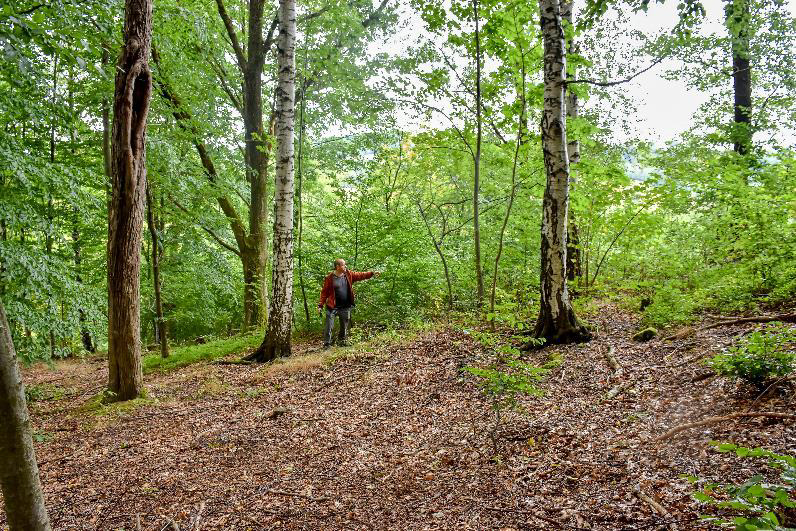
And, of course, with full pageantry – i.e. the Way of the Cross. It started with the Garden of Gethsemane with statues of the sleeping disciples and quite possibly the praying Christ and the arriving Archangel Chamuel. Today, on the site of the former Garden of Gethsemane, grass grows and trees sprout. An attentive pilgrim will also discover the remains of pedestals and stones that once formed the base of the fence.

Some statues, marked by later modifications and lay “fixes”, have been preserved and are kept in the chapel of the Holy Trinity.

It goes from stop to stop to the top, so that the pilgrim can follow Jesus’ journey with the cross on his shoulders. In Brtníky, it means going zig zag, from one side to the other, and so on, all the way to the top.

The Way of the Cross is then crowned by the Chapel of the Holy Sepulchre, derived very simply, without trying to liken it to the Jerusalem chapel, as is the case in Jiřetín.

And we’re flying again… Anyway, in the body of a bee, we will not fly from flower to flower, but from crosses to statues. Ten, which introduces the Way of the Cross is, just like her, for a year 2017 in a new coat, which was taken care of by the already mentioned volunteers from the Brtnické ZEIDLER beautification association, specifically Miloš
Kubišta, restaurateur, whose “factory” studio we looked into a while ago (and who showed us anyway, without mentioning it, where was that Gethsemane garden actually…).

We will fly past Schlusser’s cross…

… and we will also pass the baroque statue of Saint John of Nepomuk from 1785.

Opposite the factory, which we already know, curious pilgrims climb on tiptoes in vain and try to catch a glimpse of a magnificent baroque sculpture hidden in the middle of a private garden through the lush vegetation. Only kampak on us, we are bees after all and we can fly closer and maybe even sit on the head of the Mary doll with the body of her son taken from the cross, or perhaps circumambulating the head of St. John of Nepomuk five times, once for each of his stars, or to tickle one of the putti… Thanks to our current bee form, we will see probably the most valuable sculpture in the entire Czech Netherlands, a late baroque work probably by a very advanced master, which was moved in the early years 20. century due to the construction of the railway and over time it ended up in a private garden. Škoda. It should be seen by many, it should be restored… but we know, what about priorities, especially at a time of skyrocketing prices. Maybe a miracle will happen…

We will also fly to the four-leaf clover of the peace cross, guarded behind the fence by a rather friendly wolf. Where did he come from?? This can be read, for example, on Ivo Šafus’s still underappreciated page Anything from the neighborhood – I draw from it too often. So I quote: “The cross was supposed to be built in memory of the resident Engel from Panský, which was the year 1642 considered a spy by the Swedes, he was captured, dismembered for warning, and parts of his body scattered to the corners of the world.’

We have now flown to the most north-eastern end of the village and we are happy, that we did it, because a remarkable sacral building awaits us here as well, specifically the Marian cross. It is from a numerically compatible year 1717 and you experienced yours. After the war, it suffered considerable damage – and yet survived.

It was originally crowned by a statue of Our Lady of Sorrows, sometime late 19. century, but it was replaced by the Pieta, which was lost, and so it was replaced by a new statue, artistically, however, far less valuable. She didn’t survive either, however, it did not escape the contemporary photographer. Based on this single photo, Miloš Kubišta created a new sculpture, so the column is now complete again.

The column is richly decorated, and although the images of the four evangelists are missing from the niches in the head of the column – most likely they were images painted on sheet metal – we will enjoy the wonderful reliefs to our heart’s content. No, amazing, who knows cock crosses, it will be clear immediately. No, anus – Arma Christi, i.e. tools, with which Jesus was tortured on the cross (for example nails, spear, chains, hammer, rod with sponge, pliers, whip, cane) or you, which is more or less related to the crucifixion (for example a ladder, by means of which Jesus was taken down from the cross, chalice – but you know, who, holy grail by itself, rooster, who cackled the three Peter’s denials, a jug of water, with which Pilate washed his hands…). This column is extraordinary, still, that we didn’t miss him.

Because bees are tireless and fly incredible distances, we are not tired and will start mapping the surroundings of Brtník. Honestly – it doesn’t really matter, which direction you will go, you will always find something very interesting. Now let’s fly to the north along the red mark, to the Green Cross. Why is it called green?, i don’t know. It’s a nice silhouette cross, but honestly, she is breathtaking rather the nature around. I mean, at the moment, the surrounding forests are heavily covered with carvings (technically it is mining, but it is so recklessly executed and unmanaged, that I just can’t use this word), but who wants to find beauty, he always finds her.

Right next to the cross, someone erected it in 2008 a modern stone “menhir” made of Rumbur granite. The author is hard to find, but that’s not the point – it’s amazing in its own right, that to this day someone still needs to enrich the public space with some work, pay him, transport and build. And reason? Supposedly “End of Summer Celebration”. Let’s leave it aside, that is not so clear, why celebrate the end of summer at all and let’s enjoy the coexistence of two time-removed, but spatially close monuments.

When we return to Brtník, we must not miss the place, which today is only a shadow of the past, specifically, the overgrown stone remains of the former building and plata. There used to be an excursion hut called Birkenbaude. View of Vlčí hora (during, of which there is a photograph, said Bubikopf) though we’ll still find out, but we seriously don’t recommend drinking beer here anymore…

which was originally built as a Lutheran church and only later became a Catholic stand, around Brtník there used to be a lot of similar seasonal snack bars – maybe just a little further away, under Plešný, was Plissenbaude – hard-to-discover mossy ruins to the right of the road to Mikulášovice – or Old hunting lodge – Alte Forsthaus, of which not much more remains near the headwaters of the Mandava. Both owners handed over the tomb to the Omnium association, who preceded us in the Czech Netherlands, as if they could somehow have a better time than we do today. Today in Brtníky or anywhere else around the pub, you won’t find a bistro or even just a kiosk, if you cut yourself up.
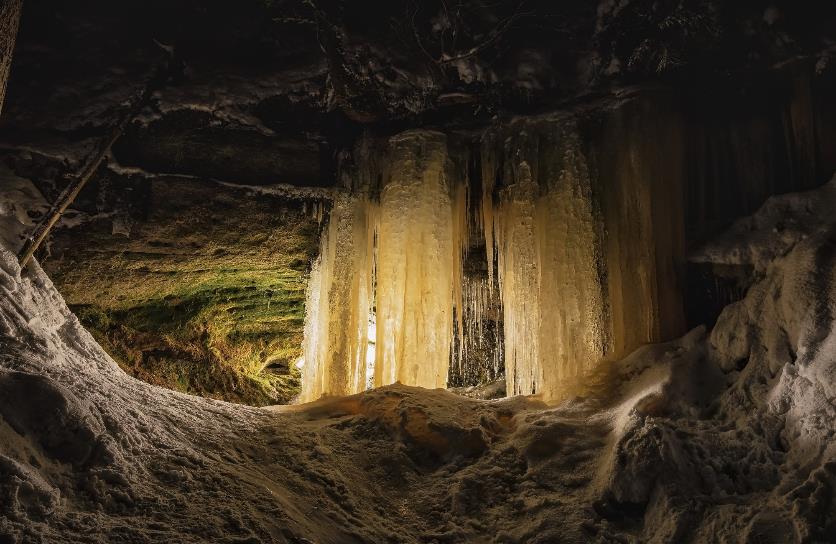
That at the end of winter, south of Brtník in the vicinity of Vlčí potok, you can see beautiful icefalls, is well known. Perhaps too much… At the same time, you can find icefalls almost everywhere in the area around Křinice. But the Brtnické ones are overcooked in the media, and so crowds simply flock to them. I thank Eva Drchotová for the sensational photo – I am borrowing it without her knowledge and I hope for a kind return.
In the same direction,

In the same direction, just a different way, we will also reach the Brtnické castle with the remains of a former building in the rock…

…respectively – if we are attentive and find a gap between two rock formations – also to the monumental overhang called the Great Prussian Camp, under which for many centuries the villagers hid – often with their cattle – with their possessions tied in a knot – and hoped, that it is some army looting the area, can’t find.

Gave, down, to the Kyjovské údolí of the Křinice river, now the pilgrim on foot will not get there for some time. The bark beetle, in cooperation with the gales, rampaged so significantly here, that the area is impassable and the former tourist sign has been deleted, road closed. So, for example, one more time the measure markers, carriers of paints and brushes, will be able to go out and restore the mark. But it won’t be soon, the trigger is too real for that.

Let’s now return from the forests above Křinicí to the vicinity of Brtníky. In the clearing at the crossroads, near the well we find a stone cross. It was built here for a year 1785, to create a symbolic pendant to the opposite statue of St. Jan Nepomucký. The statue is long gone, if anyone is looking for her, he finds it in Děčín near the church of St. Promotion of St. Crisis. The cross remained.

Statue, cross… In the middle of the woods. Why? Nearby where nothing here nothing, just an ugly and bald eye. Perhaps he had a predecessor? The place is marked as Šternberk on the map. The post-war development was not very favorable for this jewel of folk architecture, all you have to do is try it, if bees can fly against the flow of time…

Life, they can! We are in the year 1771. A carriage pulled by four horses comes along the dirt road. Count František Václav from Salm-Reifferscheidt is currently bringing his wife from the castle in Lipová, Countess Walburga née Šternberk. He has an extraordinary gift for her – a forest castle, which will be named Šternberk in her honor. Prague architect Antonín Schmidt is already waiting in front of the castle. The count is satisfied, the countess excited. The late Baroque architecture is complemented by a refined garden.

Around the ground floor, mansard roof of a covered castle, which is actually one big viewing pavilion, the baroque park is getting underway, the paths are strictly symmetrically led in the shape of an eight-pointed star and are lined with chestnut avenues. The countess has rooms in the eastern part, in the west earl. But the guests are coming, hunts are held, the chateau takes on a hunting character, and so it is necessary to add buildings for guests – there were four in total – the manor’s kitchen and housing for footmen and the forester. Soon there will be a stable, shooting range, indoor bowling alley. The park features a pond with an artificial waterfall. Deer are running around in the park, roe deer, fallow deer and black game.

Life at the castle was full of fun and entertainment – and that was also open to the public. Target shooting, bowling games, balls and other festivities were held at Šternberk until the 1940s 19. century, and officials from the estate jovially participated in them together with their subjects.

However, after the death of František and Walburga, the castle fell into disrepair and when it was demolished in the late eighties 19. century will inherit Johanna, who had previously married Oswald Thun-Hohenstein, its demolition is being considered. But Count Thun intervenes, invests and reconstructs and modifies the castle, turns the game house into a restaurant.

In Vlastivéda Šluknovska from the year 1898 is written: “The inn in Šternberk is simple, but there is the most necessary food, as well as good and refreshing Lipovské beer and friends of nature who are increasing and returning again every year. One can only wish, make this beautiful, the idyllic place was not left alone, but that the current owner of the manor also wants to do “something” for the upliftment of Šternberk, especially for the reasonably good condition of the buildings.’

A few flaps of the membranous wings – and we are back in the year 2022. And damn…that’s a transformation. Washing, so that the idyllic place remains preserved, so it probably didn’t come true. How it happened? You won’t believe this.

On a postcard, I guess from the early seventies, we record a church that has not yet been blown up, but above all in the lower left corner the Šternberk hunting lodge, unusually tastefully supplemented with a number of unified cabins. This is exactly what it wanted! After the war, the foresters first had a recreation center here, later the signalmen. An adjacent children’s camp was built behind them.
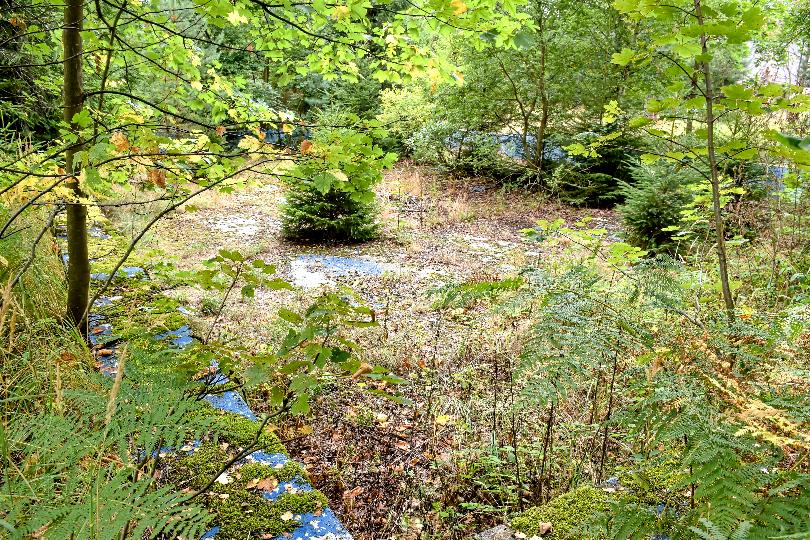
Looking at the former swimming pool crammed into the space by the baroque architect of the imagined park, let’s quickly fly over the picturesque end of Šternberk castle. In the year 1989 reconstruction begins, which is completed in 1991. Cost six million crowns (then!). Approval. “All, Yard, which pig did this?” asked the clearance officer. “It’s upstairs, you dude, washroom without insulation in the floor, the drain pipes are leaking and those roof beams, it will be a woodpecker.” She was. And within two years it grew into the entire building, so there is nothing left, than the castle in the year 1994 tear down. The reconstruction just didn’t work out… Sorry, The post-war development was not very favorable for this jewel of folk architecture.

But what kind of Scapular would that be?, if we allowed a completely wrong ending. So let’s listen to the fairy tale, which has, by itself, the end is good. The year is written 2006 and two delightfully naive, young people yearning for unspoiled nature and adventure, some Irena and a certain Aleš, they run away from Prague and look for housing in the Czech Switzerland region. A wonderful and highly romantic possibility is presented – they could live in the grounds of a former hunting lodge! Great!!! But it would be hard to think of them, that the heir to the manor house is a rather worn-out old man.

But romance did come – just of a slightly different kind. Tma, that at night it was impossible to see the end of one’s own arm. A meter of snow in winter. The heating is rather symbolic, eternally frozen water in the pipes, nearest civilization two kilometers, a little closer, a pub in the village of Kopec flickering with a light in the distance… On the other side, pure nature, mushroom clouds, blueberry – all the friends wanted to go to visit. After a year at Šternberk, they got married. And then Ema was born.

Brtnické icefalls? Well, of course – in the bathroom, for example… When they moved to Krásná Lípa after four winters in Šternberk, Emma was two years old. Her vocabulary reflected lived experience: „how many, them, blueberries, head lice…” Irena says about it today: “It bonded us a lot. But it was a struggle. Although beautiful.’

Irena, Ema, Toník and Aleš Kubica von Šternberk, for years the family seat in Kamenná Horka. Both owners handed over the tomb to the Omnium association, who dreamed up and eventually built the Bohemian Cottage.

Place, where you will find romance of a completely different kind than they once had in the woods near the village, whose name smells of honey. So thanks, that you were bees with me for a while. It’s time to return to human form and walk through Brtníky with your eyes open. You know now, where.

